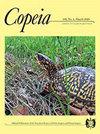The Smallest Known Free-Living White Shark Carcharodon carcharias (Lamniformes: Lamnidae): Ecological and Management Implications
IF 2.6
Q2 Agricultural and Biological Sciences
引用次数: 7
Abstract
The White Shark (Carcharodon carcharias) is a top predator cosmopolitanly distributed and heavily protected worldwide. Identification and information pertaining to White Shark nursery areas is limited yet crucial for the protection of sharks during their most vulnerable life stages. Here, we present morphometric, skeletal, and haplotypic characteristics of the smallest free-living White Shark reported to date (1066 mm TL). These characteristics correspond to a newborn White Shark smaller than those previously reported in an embryonic state but displaying the same number of rows of functional teeth as an adult. The individual was caught incidentally by an artisanal fishery operating along the Pacific coast of Baja California, near the international border between Mexico and the United States (USA). We found no genetic divergence between Isla Guadalupe and central California, two aggregation sites that have been proposed as a possible source for newborn sharks in this area. The newborn White Shark displayed the most common haplotype present among individuals at both aggregation sites. These findings provide evidence suggesting the presence of an extended nursery habitat in the Northeast Pacific, a transnational region between Mexico and USA.已知最小的自由生活白鲨Carcharodon carcharias(Lamuniformes:Lamnidae):生态和管理意义
白鲨(Carcharodon carcharias)是世界范围内分布和受到严格保护的顶级捕食者。关于白鲨保育区的识别和信息是有限的,但对于保护鲨鱼在其最脆弱的生命阶段至关重要。在这里,我们介绍了迄今为止报道的最小的自由生活白鲨(1066毫米TL)的形态计量学、骨骼和单倍型特征。这些特征对应于一只新生的白鲨,它比之前报道的胚胎状态下的小,但显示出与成年白鲨相同数量的功能性牙齿。这名个体是在墨西哥和美国(美国)之间的国际边界附近的下加利福尼亚州太平洋沿岸被一家手工渔业偶然捕获的。我们发现瓜达卢佩岛和加利福尼亚州中部之间没有基因差异,这两个聚集点被认为是该地区新生鲨鱼的可能来源。新生的白鲨在两个聚集位点都表现出最常见的单倍型。这些发现提供了证据,表明墨西哥和美国之间的跨国地区东北太平洋存在扩展的苗圃栖息地。
本文章由计算机程序翻译,如有差异,请以英文原文为准。
求助全文
约1分钟内获得全文
求助全文
来源期刊

Copeia
生物-动物学
CiteScore
2.10
自引率
0.00%
发文量
0
审稿时长
6-12 weeks
期刊介绍:
Founded in 1913, Copeia is a highly respected international journal dedicated to the publication of high quality, original research papers on the behavior, conservation, ecology, genetics, morphology, evolution, physiology, systematics and taxonomy of extant and extinct fishes, amphibians, and reptiles. Copeia is published electronically and is available through BioOne. Articles are published online first, and print issues appear four times per year. In addition to research articles, Copeia publishes invited review papers, book reviews, and compiles virtual issues on topics of interest drawn from papers previously published in the journal.
 求助内容:
求助内容: 应助结果提醒方式:
应助结果提醒方式:


